
|

|
Forum Index : Windmills : furling revisited?
| Page 1 of 2 |
|||||
| Author | Message | ||||
| Tinker Guru Joined: 07/11/2007 Location: AustraliaPosts: 1904 |
I had this brilliant  idea last night and would like to ask here if it has merit. idea last night and would like to ask here if it has merit.
It appears that HAWT always furl by rotating the propeller to face the wind side on. OK, it works but it appears to be quite complicated to set up. Why can't we furl the thing by tilting it up on a horizontal axis? There would be the normal wind seeking pivot and on it a stirrup like frame with a horizontal shaft that holds the wind generator. This allows the wind generator to tilt upwards for furling, gravity keeps it horizontal against a stop for normal wind conditions. The tail fin would have to resemble a plane's tail, with a vertical wind direction seeking vane and a horizontal furling vane. Of course, there needs to be a simple linkage to keep the horizontal vane at the same angle of attack as the tail furls through its vertical arch. I see one immediate benefit for those who have flexible PVC blades, they move away from the mast during furling, diminishing the possibility of hitting the mast. Another benefit is to be able to tilt it remotely from the ground by means of a push rod through a hollow wind seeking shaft. Looking forward to read your comments why this idea has apparently not been used so far. Klaus |
||||
Gill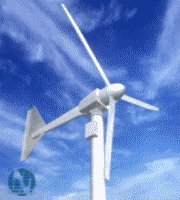 Senior Member Joined: 11/11/2006 Location: AustraliaPosts: 669 |
Sorry Klaus, you are not the first to consider that method of furling. It is perhaps the second most used on wind generators. I can only guess that others felt like me when considering this method for the F&P that the rear mounting of the typical F&P with it's large diameter did not lend itself so well to this method. It is however popular with more compact generators such as the Baldor, Amtek and many others of this type. Some pivot the tail with the gen and blades though most do not. There is, as always, a variety of ways of doing it. So no problems to go ahead with your idea though I don't know of any formula for the geometry. I guess you'll have to play with it. Good Luck and looking forward to your pics of how it's done.  was working fine... til the smoke got out. Cheers Gill _Cairns, FNQ |
||||
| GWatPE Senior Member Joined: 01/09/2006 Location: AustraliaPosts: 2127 |
hi Tinker, I have seen several with this tilt-up furling. All have some spring/damper system. All were broken when I saw them. I have seen broken springs, dampers or both. The thing I like about side furling is simplicity. Gravity will always be with us. As long as the pivot is maintained she works. Gordon. become more energy aware |
||||
| whiskey Newbie Joined: 19/06/2007 Location: IrelandPosts: 21 |
Hi Tinker, A company in Hong Kong made a range of wind turbines with furling over the top rather than to the side. The company seems to be gone now and all I have from them is a few pictures of how their wind turbines looked. In one of these pictures you can see its size in comparison to a small building and vehicle. I do have videos of these machines running on an old PC. If you want a more detailed description of their turbine I can post that, it has been some years since I spoke with the manufacturer and I never forget tech info, faces maybe, but never tech food :) I also have pictures of tail only furling where the tail is pivoted around the tail boom. It is a US design and rarely seen in the wild. Cheers, Whiskey 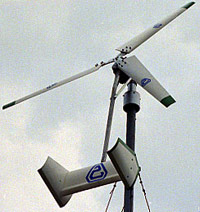
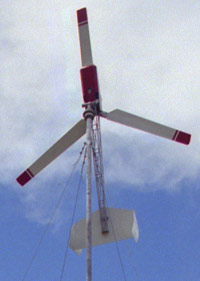
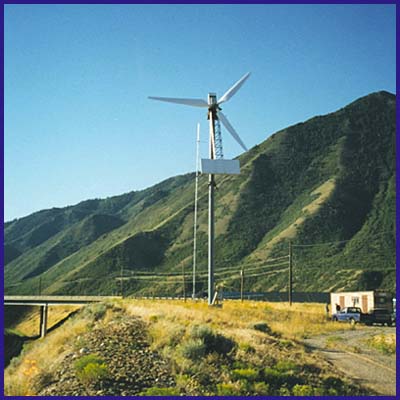
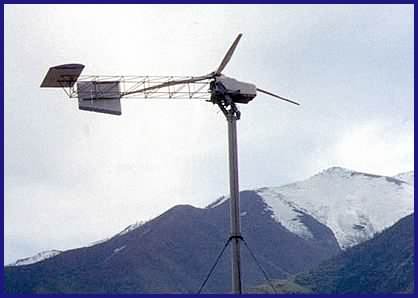
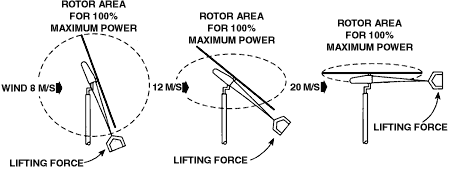
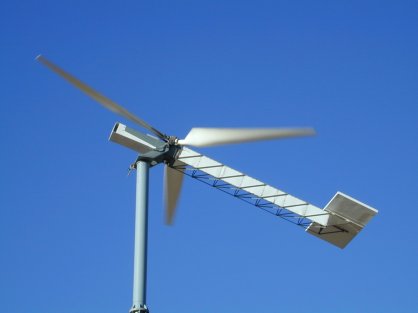
|
||||
| Robb Senior Member Joined: 01/08/2007 Location: AustraliaPosts: 221 |

This lot use a similar system. Soma Then there is the centrifugal variable pitch non furling system like on the old quirks / dunlites. Does anyone know if they could be run unloaded? |
||||
| Tinker Guru Joined: 07/11/2007 Location: AustraliaPosts: 1904 |
Thank you all who replied to my idea. So, its not new after all. I appreciate the pictures that were posted. I'll play with it some time, though at my place only smallish wind generators are possible. Gordon, I differ with your opinion regarding the 'simplicity' of side furling. Simple it is not, at least for a first timer. It was explained to me here how it works some time ago but I still could not fully picture it in my head. If I can't picture something in my head its not simple, right?  Perhaps there is an animated version for vieweing somewhere on the net? Perhaps there is an animated version for vieweing somewhere on the net? Klaus |
||||
| whiskey Newbie Joined: 19/06/2007 Location: IrelandPosts: 21 |
Any manuals I read on centrifugal controlled blades stated they can be left in an unloaded condition. However it does still place a lot of stress on the blade root and reducing the swept area into the wind is still the best way to go for small scale machines. I had a 4Kw down wind machine and it coned its blades back from the tower and the swept area was reduced by 45% as well as the blade pitch flattening. If you can get an old Dunlite, grab it. They are still worth using and same with the old Jacobs. The wind turbine pictures I posted of the larger machine use a weight that can be lowered down inside the tail and the wind speed at which it furls controlled remotely. Clever and fool proof, if anything should ever break it means the machine will always furl early. Side furling places very high levels of stress on the tower, I modeled that some time ago and then went to down wind machines and stayed with them. |
||||
| GWatPE Senior Member Joined: 01/09/2006 Location: AustraliaPosts: 2127 |
Hi tinker, sometimes explanation does not really help. You may want to look at a real windmill that uses side furling. Both my mills were made, side furling, based on an existing design. I had to make some minor adjustments as I wanted mine to start furling at 7m/s. Mine are almost fully furled at 10m/s. I oil the bronze bush on the pivot, but will add a grease nipple one day. I made a styly fin, so they look a bit modern. I think there may be some advantage with wind direction tracking using a tilt back mechanism. Gordon. become more energy aware |
||||
| KiwiJohn Guru Joined: 01/12/2005 Location: New ZealandPosts: 691 |
Significant or not I cant say but a mill that has a pivot for tilt back furling will tend (due to gyroscopic effects) to 'kick back' when there is a sudden change of wind direction. |
||||
| whiskey Newbie Joined: 19/06/2007 Location: IrelandPosts: 21 |
The machines pictured, tilt their blades up, forward and into the wind, not back. My own machines are down wind and work with the wind at all times and do not have the burden of high stress levels as with side and overhead furling. If the machine furls to the side or overhead, both will do what you stated, there is no way to stop the gyroscopic effect once you have designed it in. Any change in wind direction with an upwind machine will have the gyroscopic forces transferred into the tower and it will impart a circular motion on the tower when viewed from top down. A down wind machine where the blades never fight against the wind has major advantages and reducing swept area when it is needed most is worth it to me where our winter winds reach 80MPH each year and the odd few hours to 100MPH. |
||||
| KiwiJohn Guru Joined: 01/12/2005 Location: New ZealandPosts: 691 |
[quote]Any change in wind direction with an upwind machine will have the gyroscopic forces transferred into the tower and it will impart a circular motion on the tower when viewed from top down. [/quote] I dont understand, you mean it imparts torque in the tower? As far as I can see a change in wind direction will cause any horizontal axis wind turbine to tend to 'nod' whatever the mounting and furling system in use, downwind or upwind. Vertical furling will cause the turbine to tend to furl, or unfurl, with changes in wind direction. In the case of side furling, or no furling, when there is a sudden change in wind direction the tendency to 'nod' is transferred to a bending force on the top of the mast. Now depending on how the side furling system is arranged a sudden change in wind direction may merely result in the fin swinging around to align with the wind and the turbine will follow in its own good time and according to the centring forces built into the furling system. Thats as I see it anyway! 
|
||||
| whiskey Newbie Joined: 19/06/2007 Location: IrelandPosts: 21 |
I had to read your post several times and we are getting caught up in terminology. If what you mean by imparts torque as force, then yes. A down wind machine with blades that cone to allow their swept area to reduce and stay aligned to the wind at all times will not 'nod'. It is perfectly balanced and the gyroscopic forces are not fighting against the wind. There is no up, down or sideways furling here. The blades hinge at their root and the tip now travels in a smaller circle. Your last sentence is correct and shows another area where the free tail movement adds to the blade gyroscopic movement when you least want it. Fun isnt it? |
||||
| Robb Senior Member Joined: 01/08/2007 Location: AustraliaPosts: 221 |
Does cone furling work purely on drag? I'm thinking when the machine revs harder the blades would be forced towards an unfurled state. |
||||
| whiskey Newbie Joined: 19/06/2007 Location: IrelandPosts: 21 |
It is wind force that forces the blades to cone. The machine cant over speed because blade is no longer producing more lift than the desired amount to continue generating the alternators peak output. The blade angle changes as it cones. It works on two off set angles at the root connection point. Even in high winds I dislike excessive drag and thats where small scale wind turbines get a bad name, noise. Drag equals noise and the tips are the main offender. Each tips throws off a swirling vortex that is approx 30% to the down wind side and swirls out from the tip. I will try and get pics of this. When blades no longer fly and I have seen plenty instances where that happens, you then also get lots of drag from the trailing edge of the blade. The reynolds numbers at stations along the blade are lower than the tip and harder for noise to be generated through drag or worse again from the tips going super sonic. Some small composite blades sold that are very popular among the online retailers selling kit parts, and run so fast as to sound like a chainsaw when running at high speed. A classic example of tip noise and poor efficiency. |
||||
| KiwiJohn Guru Joined: 01/12/2005 Location: New ZealandPosts: 691 |
Whiskey, do your blades have pivots/hinges or a flexible section at the root? |
||||
| whiskey Newbie Joined: 19/06/2007 Location: IrelandPosts: 21 |
They have a hinge formed with a large pin and bushing attached to the root of the blade and is the same width of the blade. The movement this gives will reduce swept area and also flatten out the pitch as wind speed picks up. I know of one commercial machine with a flexible root area, it has had many problems. |
||||
| herbnz Senior Member Joined: 18/02/2007 Location: New ZealandPosts: 258 |
Hi Whiskey I like this concept I hope you can fill us in on more details. ie are the blades spring loaded to return to unfurled position. do the blades move indepentantly if so is balance any issue. The forces created would fit into a idea I would like to try to make generators characteristics more in line with the power in the wind . ie increase excitation naturally as wind speed increases. Herb |
||||
| whiskey Newbie Joined: 19/06/2007 Location: IrelandPosts: 21 |
Yes the blades are linked together and one large spring acts to push them back out as the wind force reduces. All the blades must move the same amoutn at the same time, otherwise vibration will be bad. There is also a large damper to prevent rapid directional changes in the blades. Are you producing an alternator with field coils? |
||||
| herbnz Senior Member Joined: 18/02/2007 Location: New ZealandPosts: 258 |
Hi Whiskey No field coils but thinking of moving magnets in as wind increases. Maybe to get charcteristics we do need to excite by coils . Herb |
||||
| whiskey Newbie Joined: 19/06/2007 Location: IrelandPosts: 21 |
Hello Herbnz, I see what you mean now. If you can make it reliable and long lasting it would be real nice. |
||||
| Page 1 of 2 |
|||||
| The Back Shed's forum code is written, and hosted, in Australia. | © JAQ Software 2025 |